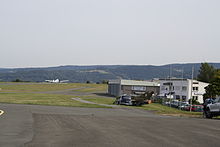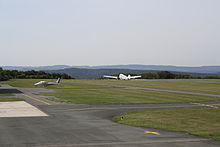Bayreuth airfield
| Bayreuth airfield | |
|---|---|

|
|
| Characteristics | |
| ICAO code | EDQD |
| IATA code | BYU |
| Coordinates | |
| Height above MSL | 488 m (1601 ft ) |
| Transport links | |
| Distance from the city center | 10 km northeast of Bayreuth |
| Basic data | |
| opening | 1950s |
| operator | City of Bayreuth |
| Terminals | 1 |
| Flight movements |
11,416 (2019) |
| Runways | |
| 06/24 | 1034 m × 30 m asphalt |
| Glider trajectory 1 | 1100 m × 30 m grass |
| Glider trajectory 2 | 900 m × 30 m grass |
| Glider trajectory 3 | 800 m × 30 m grass |
The Bayreuth airfield (on the Bindlacher Berg in the municipal areas of Bindlach and Goldkronach ) is the airfield of the Upper Franconian capital Bayreuth . Since it was taken over by the City of Bayreuth, it has been used in particular for business aviation, but also for general air traffic, among others a. as a performance base of the Bavarian Aviation Association for gliding.
location
The airfield is located five kilometers northeast of the city limits near the federal highway 9 , the federal highway 70 and the European road 48 . It can be reached with the VGN bus (line 330) with a direct stop at the airfield.
history
Laineck airfield
The predecessor was the Laineck airfield in the valley below the Oschenberg on Bindlacher Allee, which was inaugurated on August 2, 1925 with an air day. The facility, already known as an airport in 1930, raised hopes of improving the city's location away from the main railway lines. In the year mentioned, 119 incoming and 82 outgoing “air passengers” were counted.
Since 1929 it housed the propeller plane of the Bayreuth aviator Lisl Schwab , who achieved national fame as a parachutist. For flying Bayreuth prominence also belonged NS - Gauleiter and Bavarian Minister of Culture Hans Schemm , who in 1935 was killed there at the start. Adolf Hitler landed as a festival guest with a personal pilot in a Ju 52 that was waiting for him during his stays there. The airfield, which was designated as a civil airfield and was also used by glider pilots, was also approached by military aircraft.
The short history of the Laineck airfield ended with the Second World War . The area was initially used for the construction of a refugee camp and later by the Bundeswehr (Margrave barracks ). The hangar was demolished in the early 1960s.
Air base
On the Bindlacher Berg put the Air Force in 1937-38 an air base on which was the largest military airfield in Upper Franconia. From May 1939 the destroyer squadron I./ZG 52 was stationed there. Hitler , who did not want combat units to be stationed in Bayreuth, had the unit relocated to Biblis in August of the same year . From September 4, 1939, the air base was used by pilot schools and aviation schools. 1500 on- board mechanics could be trained on all common aircraft types of the Air Force, the teaching staff consisted of 350 NCOs and sergeants . All types of aircraft up to the six-engine Me 323 "Gigant" and the Heinkel He 111 Z double-hull aircraft were represented.
Repair company 6 carried out aircraft repairs, and there was also a training facility for aircraft builders in metal aircraft construction. From February 14, 1944, various close-up reconnaissance groups were stationed, and on April 5, 1945, Night Battle Group 2 was moved from Erfurt-Bindersleben with its five remaining Ju 87 dive bombers to the Bindlacher Berg.
In 1945 the air base consisted of six halls. They were north of the linking runway , the course now Goldkronacher road follows. Unlike today, the planes took off and landed in a north-west-south-east direction on a grassy area to the south.
On April 11, 1945, the air base was partially set on fire in a bombing raid, and German aircraft stationed there were destroyed. Four days later it was occupied by American troops , who built the Christensen Barracks, which was used until 1992.
Bayreuth airfield
The airfield on the Bindlacher Berg was built after the end of the Second World War on the south-eastern part of the military area that the US Army of the Luftsportgemeinschaft Bayreuth e. V. had made available, built by them and taken over by the city of Bayreuth in 1973. The license to operate as a commercial airfield was granted on April 1, 1974 by the Northern Bavaria Aviation Authority. The city of Bayreuth acquired ownership of the leased land from the Federal Republic of Germany in 1986 and expanded the site to a total of 55,511 hectares in 1996 . This enabled new glider trajectories to be built in the north of the square and the basic requirements for optimized glider operations to be created.
With large grants from the Free State of Bavaria, the City of Bayreuth successfully invested in the technical equipment for the instrument approach and departure procedure , the expansion of the runway , the construction of a new terminal with a viewing terrace and in modern equipment and machine technology. This makes it possible to reliably handle business travel up to ten tons (PPR) total flight weight even in bad weather conditions and in winter.
The runway is on a high plateau. With a runway length of 1,034 m, aircraft up to max. 5.7 t take-off weight (10 t PPR ) take off and land here. In exceptional cases, the North Bavarian Aviation Authority can grant approval to aircraft up to 20 t upon request. Due to the proximity to the airports in Nuremberg (around 90 kilometers) and Leipzig / Halle (around 190 kilometers), there is no urgent need for the use of larger aircraft. Medium-sized charter planes can be booked individually, so direct flights to Europe are possible at any time.
In the 1960s, the Cologne company Air Lloyd offered scheduled services to and from Frankfurt during the Bayreuth Festival . The machine of the type Dornier Do 28 operated in "demand air traffic according to a fixed timetable". The company was in heavy loss; In the last year of operation, 1965, only six passengers used the offer at a price of DM 75 per flight.
From 1973 there was regular service with a De Havilland Canada Twin-Otter DHC-6 from Hof via Bayreuth to Frankfurt am Main. A Beechcraft 99 also flew to Düsseldorf for a short time . From January 7, 1986, the Nürnberger Flugdienst (NFD), Eurowings Luftverkehrs AG since 1993, flew with Do 228 and - from 1992 to 1998 - ATR 42 and ATR 72 . The safety strip north of the landing area had to be expanded for the new aircraft; the total construction costs amounted to 1.9 million DM. Augsburg Airways then took over this connection with De Havilland DHC-8 turboprop aircraft , which existed until October 2001. The last scheduled flight to Frankfurt took off on October 1, 2001.
The Bayreuth airfield, however, has remained a popular and popular airfield for business aviation and other general aviation.
For the air sports airfield Bayreuth is interesting because of its multiple uses: There, found in 1999 world championships in gliding and in June 2006 the Bavarian gliding championships. For the Luftsportgemeinschaft Bayreuth, the airfield is the home base and starting point for flights in the German gliding league . The annual costs for the city are around 350,000 euros on average.
Incidents
- In May 1995, one of continued Antwerp coming twin-engine Cessna 441 Turbo by Continental air traffic to be late. It rolled over the end of the runway, barely missed a lattice mast of the runway lights and fell over the edge of the 800-meter-long steep slope on the southwest side of the Bindlacher Berg. The occupants survived the accident and were able to exit the aircraft through the rear door. Most of the 1,500 liters of kerosene in the damaged tank flowed into the ground.
- On May 18, 2007, after an engine failure, the emergency landing of a single-engine Diamond DA40 from Hof failed . The plane touched down too late, shot over the end of the runway, crossed a street, and crashed into an embankment. The pilot and his passenger survived the accident seriously injured.
- In August 2016, the aroused emergency landing of a tiltrotor - convertible aircraft of the type CV-22 Osprey of the United States Air Force followed a stir, which to acquire its cargo and the delivery of spare parts two machines of the same type. The aircraft, weighing around 18 tons, landed on the Bayreuth airfield, although this is only approved for machines with a maximum weight of 5.7 tons (10 tons PPR).
Others
The designer of the Ju 52 aircraft ("Tante Ju"), Ernst Zindel , came from the nearby Mistelbach . This was pointed out on the occasional sightseeing flights with the D-AQUI of the Deutsche Lufthansa Berlin Foundation from 1936 and, if necessary, a lap of honor was made over the place.
On May 7, 1983, an Alouette helicopter took off from Bayreuth airfield in the direction of Czechoslovakia . He flew over the Iron Curtain and landed on a meadow near Asch , where he took in a young couple from the GDR and brought them to the West . The pilot later lost his license because he had entered the air traffic control zone .
Web links
- Luftsportgemeinschaft Bayreuth e. V.
- Info page on the airfield ( Memento from May 7, 2013 in the Internet Archive )
Individual evidence
- ↑ a b Harald G. Dill, Karlhein Hetz: The air war in Northeast Bavaria . Späthling, Weißenstadt 2010, ISBN 978-3-926621-95-5 , p. 17 .
- ↑ Heimat Kurier (supplement of the Nordbayerischer Kurier ) 4/2010, pp. 10 and 11.
- ↑ Harald G. Dill, Karlhein Hetz: op. Cit. , P. 12.
- ↑ Axel Polnik: The Bayreuth Fire Brigades in the Third Reich, p. 328 ff (at Google Books)
- ↑ Harald G. Dill, Karlhein Hetz: op. Cit. , P. 18.
- ↑ BT24 of February 15, 2011 ( page no longer available , search in web archives ) Info: The link was automatically marked as defective. Please check the link according to the instructions and then remove this notice. , accessed February 4, 2014
- ↑ Air bases: Where are they now ( Memento from February 22, 2014 in the Internet Archive ), accessed on February 4, 2014
- ↑ 50 years ago in: Nordbayerischer Kurier of April 3, 2019, p. 10.
- ↑ 50 years ago in: Nordbayerischer Kurier of July 27, 2016, p. 12.
- ↑ Stephan-H. Fuchs: Bayreuth Chronicle 1992 . 1st edition. Gondrom, Bindlach 1992, ISBN 3-8112-0793-8 , p. 86 f .
- ↑ Take off at Bindlacher Berg in: Nordbayerischer Kurier of March 30, 2016, p. 16.
- ↑ Katja Auer: "We tented everything out." sueddeutsche.de, April 29, 2014, accessed on April 29, 2014
- ↑ 25 years ago in: Nordbayerischer Kurier from 16./17. May 2020, p. 8.
- ↑ Pilot has been fighting for a verdict after a crash for 13 years in: Nordbayerischer Kurier from May 21, 2020, p. 17.
- ^ Air Force Base Bayreuth in: Nordbayerischer Kurier, August 12, 2016, p. 13.
- ↑ Peter Engelbrecht: Exchange mower for woman. Reports from Upper Franconia . 2nd Edition. Boomerang, Bayreuth 2004, ISBN 3-929268-18-3 , p. 48 ff .




